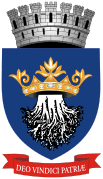Brașov
| Municipiul Brașov | |||
|---|---|---|---|
| City | |||
|
From top, left to right: Fountain in Council Square, Council House, panoramic view of the Old Town, Hollywood-like sign on Tâmpa, Republic Street, Black Church, aerial view of St. Nicholas Church | |||
| |||
 Location of Brașov | |||
|
Municipiul Brașov Location of Brașov | |||
| Coordinates: 45°40′N 25°37′E / 45.667°N 25.617°ECoordinates: 45°40′N 25°37′E / 45.667°N 25.617°E | |||
| Country |
| ||
| County |
| ||
| Status | County capital | ||
| Founded | 1234 | ||
| Government | |||
| • Mayor | George Scripcaru (Ind.) | ||
| Area | |||
| • City | 74 km2 (29 sq mi) | ||
| • Metro | 1,368.5 km2 (528.4 sq mi) | ||
| Elevation | 538 m (1,765 ft) | ||
| Population (2011 census[1]) | |||
| • City | 253,200 | ||
| • Density | 853/km2 (2,210/sq mi) | ||
| • Metro | 369,896 | ||
| Demonym(s) | brașovean, brașoveancă (ro) | ||
| Population by ethnicity | |||
| • Romanians | 91.3% | ||
| • Hungarians | 7.1% | ||
| • Germans | 0.5% | ||
| • Gypsies | 0.4% | ||
| • Jews | 0.05% | ||
| • Lipovans | 0.05% | ||
| • Italians | 0.036% | ||
| Time zone | EET (UTC+2) | ||
| • Summer (DST) | EEST (UTC+3) | ||
| Postal code | RO 500xxx | ||
| Area code(s) | (+40) 268 | ||
| Vehicle registration | BV | ||
| Website |
www | ||
Brașov (Romanian pronunciation: [braˈʃov]; Hungarian: Brassó, also known by other alternative names) is a city in Romania and the administrative centre of Brașov County.
According to the last Romanian census, from 2011, there were 253,200 people living within the city of Brașov, making it the 7th most populous city in Romania, and the metropolitan area is home to 369,896 residents.[1]
Brașov is located in the central part of the country, about 166 kilometres (103 miles) north of Bucharest and 380 kilometres (236 miles) from the Black Sea. It is surrounded by the Southern Carpathians and is part of the Transylvania region.
The city is notable for being the birthplace of the national anthem of Romania and for hosting the Golden Stag International Music Festival.
Etymology
The city was described in 1235 AD under the name Corona, a Latin word meaning "crown", a name given by the German colonists. According to D. Moldovanu, the name of Braşov came from the name of local river named Bârsa (pronounced and Bărsa). Bărsa was adopted by Slavs and transformed in Barsa and later in Barsov and finally in Brasov[2] According to Binder, the current Romanian and the Hungarian name Brassó (Hungarian pronunciation: [ˈbrɒʃːoː]) are derived from the Turkic word barasu, meaning "white water" with a Slavic suffix -ov.[3] Other linguists proposed various etymologies including an Old Slavic anthroponym Brasa.[4][5]
The first attested mention of Brașov is Terra Saxonum de Barasu ("Saxon Land of Baras") in a 1252 document. The German name Kronstadt means "Crown City" and is reflected in the city's coat of arms as well as in its Medieval Latin name, Corona. The two names of the city, Kronstadt and Corona, were used simultaneously in the Middle Ages, along with the Medieval Latin Brassovia.
From 1950 to 1960, during part of the Communist period in Romania, the city was called Orașul Stalin (Stalin City), after the Soviet leader Joseph Stalin.[6]
History
The oldest traces of human activity and settlements in Brașov date back to the Neolithic age (about 9500 BCE). Archaeologists working from the last half of the 19th century discovered continuous traces of human settlements in areas situated in Brașov: Valea Cetăţii, Pietrele lui Solomon, Șprenghi, Tâmpa, Dealul Melcilor, and Noua. The first three locations show traces of Dacian citadels; Șprenghi Hill housed a Roman-style construction. The last two locations had their names applied to Bronze Age cultures—Schneckenberg ‘Hill of the Snails’ (Early Bronze Age[7]) and Noua 'The New’ (Late Bronze Age[8]).
German colonists known as the Transylvanian Saxons played a decisive role in Brașov's development. These Germans were invited by Hungarian kings to develop towns, build mines, and cultivate the land of Transylvania at different stages between 1141 and 1300. The settlers came primarily from the Rhineland, Flanders, and the Moselle region, with others from Thuringia, Bavaria, Wallonia, and even France.
In 1211, by order of King Andrew II of Hungary, the Teutonic Knights fortified the Burzenland to defend the border of the Kingdom of Hungary. On the site of the village of Brașov, the Teutonic Knights built Kronstadt – the city of the crown.[9] Although the crusaders were evicted by 1225, the colonists they brought in remained, along with local population, as did three distinct settlements they founded on the site of Brașov:
- Corona, around the Black Church (Biserica Neagră);
- Martinsberg, west of Cetățuia Hill;
- Bartholomä, on the eastern side of Sprenghi Hill.

Germans living in Brașov were mainly involved in trade and crafts. The location of the city at the intersection of trade routes linking the Ottoman Empire and Western Europe, together with certain tax exemptions, allowed Saxon merchants to obtain considerable wealth and exert a strong political influence. They contributed a great deal to the architectural flavor of the city. Fortifications around the city were erected and continually expanded, with several towers maintained by different craftsmen's guilds, according to medieval custom. Part of the fortification ensemble was recently restored using UNESCO funds, and other projects are ongoing. At least two entrances to the city, Poarta Ecaterinei (or Katharinentor) and Poarta Șchei (or Waisenhausgässertor), are still in existence. The city center is marked by the mayor's former office building (Casa Sfatului) and the surrounding square (piaţa), which includes one of the oldest buildings in Brașov, the Hirscher Haus. Nearby is the "Black Church" (Biserica Neagră), which some claim to be the largest Gothic style church in Southeastern Europe.
The cultural and religious importance of the Romanian church and school in Șchei is underlined by the generous donations received from more than thirty hospodars of Moldavia and Wallachia, as well as that from Elizabeth of Russia. In the 17th and 19th centuries, the Romanians in Șchei campaigned for national, political, and cultural rights, and were supported in their efforts by Romanians from all other provinces, as well as by the local Greek merchant community. In 1838 they established the first Romanian language newspaper Gazeta Transilvaniei and the first Romanian institutions of higher education (Școlile Centrale Greco-Ortodoxe - "The Greek-Orthodox Central Schools", today named after Andrei Șaguna). The Holy Roman Emperor and sovereign of Transylvania Joseph II awarded Romanians citizenship rights for a brief period during the latter decades of the 18th century.
In 1850 the town had 21,782 inhabitants: 8,874 (40.7%) Germans, 8,727 (40%) Romanians, 2,939 (13.4%) Hungarians.[10] In 1910 the town had 41,056 inhabitants: 10,841 (26.4%) Germans, 11,786 (28.7%) Romanians, 17,831 (43.4%) Hungarians. [10] In World War I, the town was occupied by Romanian troops between 16 August and 4 October in 1916 during Battle of Transylvania.
In 1918, after the Proclamation of union of Alba Iulia (adopted by the Deputies of the Romanians from Transylvania), Deputies of the Saxons from Transylavania supported it, with their vote to be part of Romania, and declared their allegiance to the new Romanian state. The inter-war period was a time of flourishing economic and cultural life in general, which included the Saxons in Brașov as well. However, at the end of World War II many ethnic Germans were forcibly deported to the Soviet Union, and many more emigrated to West Germany after Romania became a communist country.

Jews have lived in Brașov since 1807, when Aron Ben Jehuda was given permission to live in the city, a privilege until then granted only to Saxons. The Jewish community of Brașov was officially founded 19 years later, followed by the first Jewish school in 1864, and the building of the synagogue in 1901. The Jewish population of Brașov was 67 in 1850, but it expanded rapidly to 1,280 people in 1910 and 4,000 by 1940. Today the community has about 230 members, after many families left for Israel between World War II and 1989.
Like many other cities in Transylvania, Brașov is also home to a significant ethnic Hungarian minority.
During the communist period, industrial development was vastly accelerated. Under Nicolae Ceaușescu's rule, the city was the site of the 1987 Brașov strike. This was repressed by the authorities and resulted in numerous workers being imprisoned.
Economy

Industrial development in Brașov started in the inter-war period, with one of the largest factories being the airplane manufacturing plant (IAR Brașov), which produced the first Romanian fighter planes, which were used in World War II against the Soviets. After Communist rule was imposed, the plant was converted to manufacture of agricultural equipment, being renamed "Uzina Tractorul Brașov" (internationally known as Universal Tractor Brașov).
Industrialization was accelerated in the Communist era, with special emphasis being placed on heavy industry, attracting many workers from other parts of the country. Heavy industry is still abundant, including Roman, which manufactures MAN AG trucks as well as native-designed trucks and coaches. Although the industrial base has been in decline in recent years, Brașov is still a site for manufacturing hydraulic transmissions, auto parts, ball-bearings, helicopters (at the nearby IAR site in Ghimbav), building materials, tools, furniture, textiles, shoes. There is also a large brewery.
The large longwave Bod Transmitter, a broadcasting facility, is located near Brașov, at Bod.
Demographics
| Historical population of Brașov | |||||||||||||
| Year | Population | %± | |||||||||||
|---|---|---|---|---|---|---|---|---|---|---|---|---|---|
| 1890 | 30,781 | — | |||||||||||
| 1900 | 34,511[11] | 12.1% | |||||||||||
| 1910 census | 41,056 | 18.9% | |||||||||||
| 1930 census | 59,232 | 44.2% | |||||||||||
| 1948 census | 82,984 | 40% | |||||||||||
| 1965 estimate | 140,500[12] | 69.3% | |||||||||||
| 1975 estimate | 206,156[13] | 46.7% | |||||||||||
| 1983 estimate | 331,240[14] | 60.6% | |||||||||||
| 1992 census | 323,736 | −2.2% | |||||||||||
| 2002 census | 284,596 | −12% | |||||||||||
| 2011 census | 253,200 | −11.0% | |||||||||||
Brașov has a total population of 253,200 (2011 census). Its ethnic composition includes:
- Romanians: 208,019 (91.3%)
- Hungarians: 16,172 (7.1%)
- Germans: 1,079 (0.5%)
- Romani people: 916 (0.4%)
- Other ethnicities: 1,037 (0.7%)
In 2005, the Brașov metropolitan area was created. With its surrounding localities, Brașov had 369,896 inhabitants as of 2011.[1]
Education
Primary Schools
- 30 Primary Schools
High Schools
- Colegiul National “Andrei Șaguna”
- Colegiul National “Dr. Ioan Meșotă”
- Colegiul National de Informatică “Grigore Moisil”
- Colegiul National “Unirea”
- Colegiul Național "Áprily Lajos"
- Liceul "Andrei Muresanu"
- Liceul Teoretic "J. Honterus"
- Colegiul de Stiințe ale Naturii "E. Racoviță"
- Liceul "Nicolae Titulescu"
- Liceul de Artă
- Liceul cu Program Sportiv
- Colegiul de stiințe "Grigore Antipa"
- Liceul Teoretic "C. Brancoveanu"
- Seminarul Teologic Liceal Ortodox "D. Staniloaie"
- Colegiul Tehnic "Astra"
- Colegiul Tehnic "Mircea Cristea"
- Colegiul Tehnic "Iosif Silimon"
- Colegiul Tehnic "Sfintii Voievozi"
 Transylvania University Brașov
Transylvania University Brașov - Grupul Școlar de Arte si Meserii
- Colegiul Tehnic "Remus Radulet"
- Colegiul Tehnic Feroviar
- Grupul Scolar Industrial Auto
- Colegiul Tehnic "Maria Baiulescu"
- Grupul Scolar Ind. de Constr. Montaj
- Colegiul National Ec. "Andrei Barseanu"
- Grupul Scolar Silvic "Dr. N. Rucareanu"
- Grupul Scolar de Turism si Alim. Publica
- Liceul "FEG"
 Transylvania University of Brașov logo
Transylvania University of Brașov logo - Liceul "Europa Unita"
Universities:
- Transylvania University of Brașov
- George Bariţiu University
- Spiru Haret University
- Christian University Dimitrie Cantemir
- Academia Fortelor Aeriene Henri Coanda
- Fundatia Univ. Sf. Apostoli Petru si Pavel
- Universitatea Sextil Puscariu
- Universitatea Romano Canadiana
Transportation


The Brașov local transport network is well-developed, with around 50 bus and trolleybus lines. There is also a regular bus line serving Poiana Brașov, a nearby winter resort. All are operated by RAT Brașov. Because of its central location, the Brașov railway station is one of the busiest stations in Romania with trains to/from most destinations in the country served by rail.
_-_train_station_-_interior.jpg)
The construction of Braşov Airport[15] was initiated by Intelcan Canada on April 15, 2008. Although construction was planned to be finalized in 24 to 30 months, works have lagged and there is no term by which it will be operational. The project consists of a terminal capable of handling 1 million passengers per year and a 2,800-metre-long (9,200-foot) runway. The A3 highway is also planned to pass the city. However, there is no foreseeable date for starting construction.

Tourism

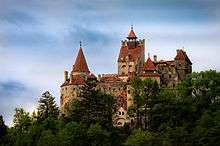
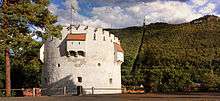

With its central location, Brașov is a suitable location from which to explore Romania, and the distances to several tourist destinations (including the Black Sea resorts, the monasteries in northern Moldavia, and the wooden churches of Maramureș) are similar. It is also the largest city in a mountain resorts area. The old city is very well preserved and is best seen by taking the cable-car to the top of Tâmpa Mountain.
Temperatures from May to September fluctuate around 23 °C (73 °F). Brașov benefits from a winter tourism season centered on winter sports and other activities. Poiana Brașov is the most popular Romanian ski resort and an important tourist center preferred by many tourists from other European states.
The city also has several restaurants that serve local as well as international cuisine (e.g. Hungarian and Chinese). Some of these are situated in the city center.
Sights
- Biserica Neagră ("The Black Church"), a celebrated Gothic site - the building dates from 1477, when it replaced an older church (demolished around 1385). Its acquired the name after being blackened by smoke from the 1689 great fire.
- Casa Sfatului ("The mayor's former office building"). The administration for Brașov was here for more than 500 years.
- Biserica Sf. Nicolae (St. Nicholas Church), dating back to the 14th century.
- The First Romanian School, a museum with the first Romanian printing press among many other firsts.
- The Rope Street, the narrowest street in Romania.
- Șchei, the historically Bulgarian but then Romanian neighborhood outside of the old walled city.
- Catherine's Gate, the only original city gate to have survived from medieval times.
- Şchei Gate, next to Catherine's Gate, built in 1827.
- The Orthodox church of the Dormition of the Theotokos, built in 1896.
- Muzeul Prima Carte Românească, a museum exhibiting the first book printed in the Romanian language.
- Tâmpa, a small mountain in the middle of the city (900m above sea level), a sightseeing spot near the old city center.
- The "Brașov Citadel Fortress" - Cetățuia Brașovului
- The nearby Bran Castle, attracting many fans of Dracula and often (but incorrectly) said to have been the home of Vlad the Impaler.[16]
- Poiana Brașov, mainly a ski resort but also a sightseeing spot.
- Râșnov Fortress, above the nearby town of Râșnov, is a restored peasant fortress
- Prejmer Fortress, in the nearby commune of Prejmer
International relations
Twin towns – Sister cities
Brașov is twinned with:
Sport
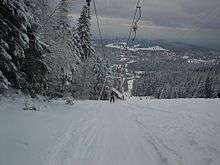
The city has a long tradition in sports, the first sport associations being established at the end of the 19th century (Target shooting Association, Gymnastics School). The Transylvanian Sports Museum is among the oldest in the country and presents the evolution of consecrated sports in the city. During the communist period, universiades and daciades (derived from "dacian") were held, where local sportsmen were obliged to participate. Nowadays, the infrastructure of the city allows other sports to be practiced, such as football, rugby, tennis, cycling, handball, gliding, skiing, skating, mountain climbing, paintball, bowling, swimming, target shooting, basketball, martial arts, equestrian, volleyball or gymnastics. Annually, at "Olimpia" sports ground, the "Brașov Challenge Cup" tennis competition is held.
The only football champion team based in the city was Colţea Brașov, winning the championship in 1928 and managing second place in 1927, in only 10 years of existence (1921–1931). It was succeeded by Brașovia Brașov. Brașov hosted the Group A fixtures of the 2008 IIHF World Championship Division II ice hockey tournament. There were 15 games held between April 3 and April 13.
Brașov hosted the 2013 European Youth Winter Olympic Festival.
As of 2012, Brasov is hosting two trail semi-marathons: Semimaraton "Intersport Brasov" and Brasov Marathon.
In November 2013, Brasov submitted their bid for the 2020 Winter Youth Olympics. They are up against Lausanne, Switzerland to be awarded the event. In December that year, the city was signed the Youth Olympic Game Candidature Procedure. The host city will be announced in July 2015[20]
Local teams
- FC Brașov – football club
- ASC Corona Brașov – football club, women's handball and ice hockey club
- CSU Brașov – basketball team
- CFR Brașov – rugby football club
- Bridge Club Brașov – contract bridge club
Sports venues
- Planned
- Brașov Arena (23,000 seats) – planned football stadium on the site of the former Municipal Stadium
- Existing
- Silviu Ploeșteanu Stadium (8,500 seats) - built in 1960 for football, floodlights were installed in 2009
- Dumitru Popescu Colibași Sports Hall (2,300 seats) – built around 1970 for indoor sports: handball, basketball, volleyball, sometimes others
- Brașov Olympic Ice Rink (2,000 capacity: 1,600 seated, 400 standing) – inaugurated on February 18, 2010, used mainly for ice hockey and public skating
- Demolished
- Municipal Stadium (30,000 capacity) – built in 1975, used for 1 May and 23 August parades, rarely used for football matches (demolished in 2008)
- Others
- Paradisul Acvatic - aquatic complex with 40m long swimming pool and three jumping platform (1m, 3m, 5.20m).
Media
The city of Braşov is home to several local media publications such as Transilvania Express, Monitorul Express, Bună Ziua Braşov or Braşovul Tău.[21] Also, several local television stations exist, such as RTT, MIX TV and Nova TV.[22]
Gallery
-

Romanian Church of Brașov
-

Brașov by Ludwig Rohbock
-

Brașov at Night
-

Brașov seen from Tâmpa Mountain
-

The famous Hollywood-like sign on top of Mt. Tâmpa
-

Brașov Main Square
-
Council of Brașov County
-

Str. Lunga
-
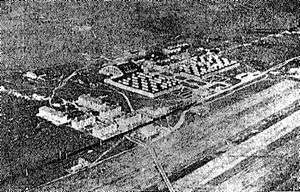
IAR Factory 1940
-
Brașov Council Building
-

Brașov Council Building at night
-
Brașov Council Square
-
The Black Church, or Biserica Neagră
-

Brașov from the White Tower
-

Brașov Council Square at night
-

The Black Church (Biserica Neagră) (from Warthe Hill)
-

Biserica Neagră (from Warthe Hill)
-
.jpg)
Ecaterina Gate (built in 1559)
-
.jpg)
Saint Nicholas Church
-
.jpg)
Council Square (from Warthe Hill)
-
Brașov City Wall
-

The White Tower watchtower/fortification
-

Bran Castle
-
View of Brașov from Piatra Mare Mountain
-

View of Brașov
-

Three-dimensional view of Brașov
-
Sunset in Brașov
-
.jpg)
-

Ecaterina Gate
-

Brașov Olympic Ice Ring
-
.jpg)
-

Railway station
-
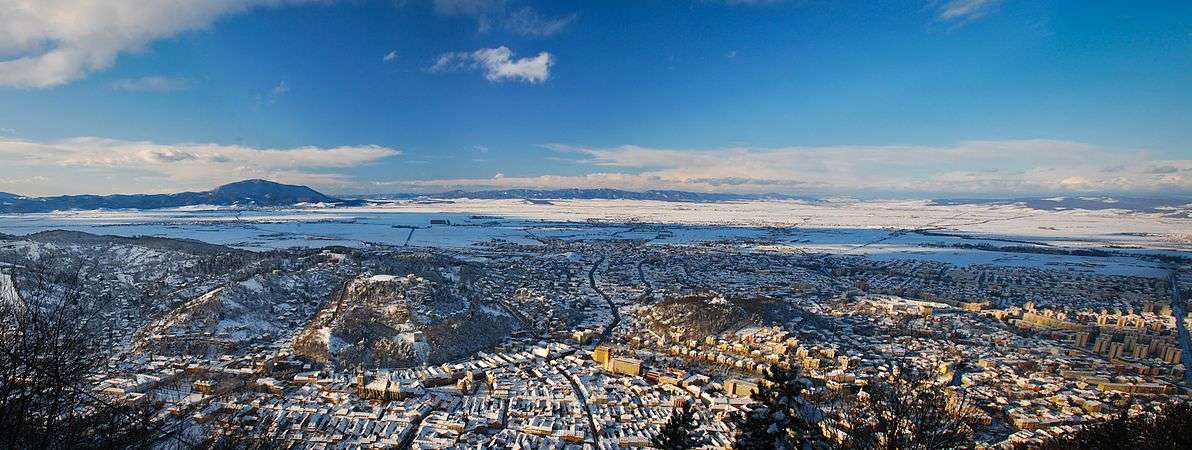
-
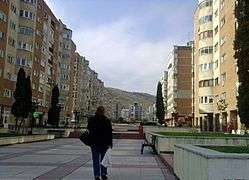


See also
Notes
- 1 2 3 "Population at 20 October 2011" (in Romanian). INSSE. 5 July 2013. Retrieved 5 July 2013.
- ↑ Dragoş Moldovanu, Toponimie de origine romană în Transilvania şi în sud-vestul Moldovei, Anuarul de lingvistică şi istorie literară, XLIX-L, 2009-2010, Bucuresti, p 59
- ↑ Alexandru Madgearu, "Români şi pecenegi în sudul Transilvaniei", Editura Economică, 2005, ISBN 973-709-158-2
- ↑ Draganu Nicolae "Români in veacurile IX—XIV pe baza toponimiei si a onomasticei” (The Romanians in the 9th - 14th Centuries According to Toponymy and Onomastics), Imprimeria Nationala, 1933, Bucuresti, p.560
- ↑ Austerlitz, Robert ""Brasov-Brasso'-Kronstadt-Berries and Bushes," in Xenia Slavica; Papers Presented to Gojko Ruzicic on the Occasion of his Seventy-Fifth Birthday, 2 February 1969, Rado Lencek and Boris O. Unbegaun, eds. (The Hague: Mouton, 1957),p.19
- ↑ Brasov | Travel To Romania
- ↑ Coles & Harding 1979, p. 140.
- ↑ Coles & Harding 1979, p. 410.
- ↑ Mediaeval studies, Volumes 17-18, Pontifical Institute of Mediaeval Studies, 1955, Toronto, Canada, An annual journal of scholarship, History, ISSN 0076-5872
- 1 2 Erdély etnikai és felekezeti statisztikája
- ↑ Encyclopædia Britannica Eleventh Edition
- ↑ Dictionar Enciclopedic Roman vol.IV, Editura Politica Bucuresti, 1966 (Romanian)
- ↑ Statele Lumii, Editura Stiintifica si Enciclopedica Bucuresti, 1976 (Romanian)
- ↑ Statele Lumii, Editura Stiintifica si Enciclopedica Bucuresti, 1985 (Romanian)
- ↑ Website of the Braşov Airport
- ↑ Middleton, Christopher (11 May 2014). "Buy a stake in Dracula's castle". Daily Telegraph.
- ↑ Tampere - Finlanda
- ↑ "Sister Cities International (SCI)". Sister-cities.org. Retrieved 2013-04-21.
- ↑ News Report concerning the Twinning with Linz
- ↑ 2020 Winter Youth Olympics Brasov Romania
- ↑ "Archived copy" (PDF). Archived from the original (PDF) on 2006-02-14. Retrieved 2014-10-18.
- ↑ http://infoportal.rtv.net/media~posturi-tv~din-brasov.html
References
- Coles, John; Harding, A.F. (1979). The Bronze Age in Europe pages 140’'. Routledge. ISBN 978-0-416-70650-5.
- "O istorie a Brașovului" ("A history of Brasov") - Ion Dumitrașcu, Mariana Maximescu, Phoenix, Brașov, 2001
- "Fortificația dacică de la Brașov - Pietrele lui Solomon" ("The Dacian citadel from Brașov - Pietrele lui Solomon"), Fl. Costea, CumidavaXX, Braşov, 1996
- "Săpăturile de salvare de pe dealul Șprenghi" ("The diggings for saving [the archaeological evidences] from Șprenghi Hill" - the hill was a quarry) A. Alexandrescu, N. Constantinescu, București, 1959
- "Die spätneolitischen Ansiedlungen mit bemalter Keramik aus oberem Laufe des Altflusses", J. Teutsch, Mitteilungen der Prehistorischen Komision, I, Wien.
Further reading
- "Kronstadt", Austria-Hungary, Including Dalmatia and Bosnia, Leipzig: Karl Baedeker, 1905, OCLC 344268
External links
-
 Brașov cultural itinerary travel guide from Wikivoyage
Brașov cultural itinerary travel guide from Wikivoyage
| Wikimedia Commons has media related to Brașov. |
| Wikivoyage has a travel guide for Brașov. |
| Wikisource has the text of the 1911 Encyclopædia Britannica article Brassó. |
- City Hall Official Website;
- Tourism Official Website;
- Weather in Brașov
- German Cultural Center, kulturzentrum-kronstadt.ro
- Art Museum Brașov, muzeulartabv.ro


